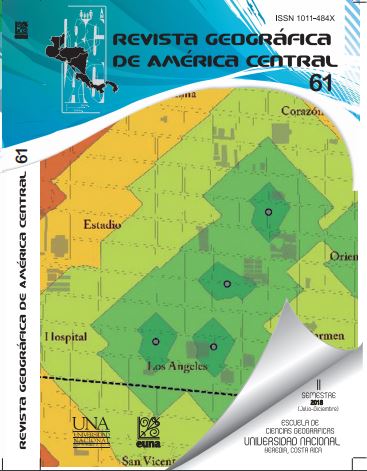GNSS Tools Used in Teaching Geography and Cartography: Methodological Aspects
DOI:
https://doi.org/10.15359/rgac.61-2.3Keywords:
GPS, GNSS data, georeferenced, orthorectification, docencAbstract
The article presents the main methodological aspects acquired during the two years of execution of the project "Application of the GPS tool in the teaching of Cartography". It describes the methodology used, detailing the processes and steps followed to meet the objectives, tasks and activities proposed in the formulation of the project. It describes the different technical phases, indicating the programs and tools used, as well as the main difficulties faced in each process. In addition, the main products are shown: the high precision point spatial data bank, the mosaic of georeferenced aerial photographs and the mosaic of orthorectified images, performing an analysis of the results obtained and presenting the main conclusions and recommendations derived from the methodological process developed.
References
ArcGIS Resources. (2016). Georreferenciación y sistemas de coordenadas. Recuperado de http://resources.arcgis.com/es/help/getting-tarted/articles/026n0000000s000000.htm Consultado el 17 de enero de 2017.
Brunini, C., Sánchez, L., Dalda, A., Cano, M. A., Sánchez, J. A., Valdés, M. & López, P. G. (2010). Apuntes del X Curso de GPS en Geodesia y Cartografía. Instituto Geográfico Nacional de España y Agencia de Cooperación Española. Montevideo, Uruguay.
Centro Nacional de Procesamiento de Datos GNSS (CNPDG). (2017). xyz_flh_wgs84 (hoja de cálculo). Universidad Nacional. Heredia, Costa Rica. Recuperado de http://www.cnpdg.una.ac.cr/index.php/download/software/transformaciones-cr/category/6-transcr.
Consultado en mayo de 2015.
Comisión Interdepartamental de Estadística y Cartografía de Andalucía. (2011). NTCA 02002 Observación y procesamiento GNSS. Normas técnicas cartográficas de Andalucía. Junta de Andalucía. Sevilla España. Recuperado de https://www.juntadeandalucia.es/institutodeestadisticaycartografia/ieagen/
sea/ntca/02_procesos/02002_Observacion_procesamiento.pdf. Consultado el 20 de noviembre de 2016.
García, D. (2008). Sistema GNSS (Global Navigation Satellite System). (Proyecto de fin de carrera). Escuela Politécnica Superior. Universidad Autónoma de Madrid. Madrid, España. 104 p.
Instituto Geográfico Agustín Codazzi (IGAC). (2016). Red MAGNA ECO. Recuperado de http://www.igac.gov.co/wps/portal/igac/raiz/iniciohome/TramitesServicios/
FueraDeServicio/!ut/p/c4/04_SB8K8xLLM9MSSzPy8xBz9CP0os3hHT3d_
JydDRwN3A083A08jJ1MDlxBXYwsnE_2CbEdFAGrs9jg!/WCM_PORTLET=PC_7
_AIGOBB1A0G0IF0I2B50DTE38R4_WCM&WCM_GLOBAL_CONTEXT=/wps/wcm/connect/Web+-+Tramites+y+Servicios/Servicios/Servicios/Informacion+Geodesica/Red+MAGNA+ECO/.
Consultado el 21 de noviembre de 2016.
International GNSS Service (IGS). (2017). IGS Product Availability. Recuperado de https://igscb.jpl.nasa.gov/components/prods_cb.html Consultado en mayo de 2015.
Jahic, E. (2016). GNSS Calendar and Utility. Recuperado de http://www.gnsscalendar.com/. Consultado en mayo de 2015.
National Geospacial - Intelligence Agency (NGA). (2015). NGA EGM96 Geoid Calculator. Recuperado de http://earth-info.nga.mil/GandG/wgs84/gravitymod/egm96/intpt.html. Consultado el 30 de mayo de 2016.
Trimble®. (2005). Manual de Referencia Trimble® Business Center Heavy Construction Edition, Versión 1.20. Ohio, EEUU: Trimble Navigation Limited.
Trimble®. (2005). Guía del usuario Trimble® Business Center. Ohio, EEUU: Trimble Navigation Limited.
Trimble®. (2009). Hoja de datos Sistema GPS Trimble® R4. Ohio, EEUU: Trimble Navigation Limited.
Sistema de Referencia Geocéntrico para las Américas (SIRGAS (2017.) SIRGAS de operación continua Consultado en mayo de 2015. http://www.sirgas.org/es/sirgas-con-network/stations/station-list/
Sistema de Referencia Geocéntrico para las Américas (SIRGAS). (2017). Coordenadas semanales de las estaciones SIRGAS-CON. Recuperado de http://www.sirgas.org/index.php?id=153 Consultado en mayo de 2015.
Downloads
Published
How to Cite
Issue
Section
License
Proposed policy for journals offering Open Access
Authors publishing their works in the Journal acknowledge and agree to the following terms:
a) Authors retain the copyrights to their works and guarantee the Journal the right to be the first to publish their works, under the Creative Commons License Attribution-NonCommercial-ShareAlike 4.0 International, CC BY-NC-SA 4.0 International (https://creativecommons.org/licenses/by-nc-sa/4.0/deed.es), which allows others to share works upon complying with the acknowledgment of authorship and mention of the Journal as the original publisher of the work.
b) Authors are permitted to separately establish additional agreements for the non-exclusive distribution of the official edition of the work published in the Journal (for example, authors may desire to place the work in an institutional repository or incorporate it into a book that is to published elsewhere) so long they acknowledgment to recognize the Journal as the original publisher. The aforementioned additional agreements must respect the terms of the non-profit character and sharing philosophy of the original license (CC BY-NC-SA 4.0 International, https://creativecommons.org/licenses/by-nc-sa/4.0/deed.es).
c) Authors are encouraged to archive the post-print or editor/PDF version in Open Access repositories.






 REVGEO is licensed under https://creativecommons.org/licenses/by-nc-sa/4.0/deed.es
REVGEO is licensed under https://creativecommons.org/licenses/by-nc-sa/4.0/deed.es
.svg_4.png)

_(1).png)
_(1)_(1)_(1)_1.png)
(2)(1)(1)(1).png)
